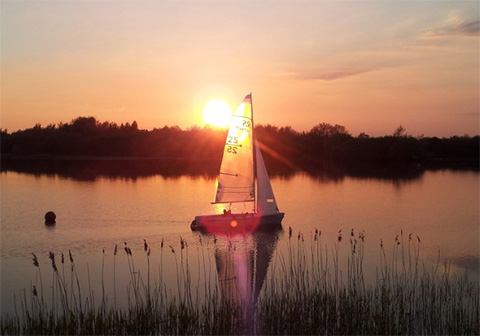Keep calm
Sam Llewellyn muses on the frustrations and joys that little or no breeze can bring.

Non-sailing people are often slightly awestruck by their sailing friends. There go Gemma and Harry, they think, wouldn’t say boo to a goose. Add water, though, and they turn into figures of practically supernatural ruggedness, laughing in the teeth of howling gales, braving tsunamis on a daily basis and zipping from continent to continent on a whim.
Little do they know. For of course if Gemma and Harry bend an ear to the weather forecast, there is little need for such tough-eggery. The British July brings with it hefty spells of calm, or anyway of winds below F2. During these, the only way for people at sea to demonstrate their personal toughness is by not going mad with frustration.
Wallowing in the swell
In a F2 your average cruising boat will wallow in the swell, admiring its reflection in the glassy surface. The sails hang limp, from time to time emitting a rumpling sound. The poet Coleridge claimed that in these circumstances slimy things did crawl with legs upon the slimy sea, and experience suggests that he got it just about right.
Countermeasures are often ineffective. The skipper on passage will pull out a good book, and fail to concentrate on it thanks to the slatting and banging of the rig. The coasting skipper will fire up the engine and head in a cloud of fumes for a cove in which a bit of light swimming can be done. While the crew splosh around like dolphins, the skipper will gnaw the fingernails, hoping that the breeze does not get up, come onshore, and send boat and swimmers on to the rocks.
Catspaws of breeze
Racing people have it even worse. During calms they will be seen hurtling around foredecks hauling gennikers the size of tennis courts into the soupy air. They will scream at the helmsman as the catspaws of breeze creep across the water, ruffle the diaphanous nylon, and die away to nothing. The helmsman will bury his face in his hands. Eventually, the shouting dies away. Another catspaw, back it comes. And so the long day wears on.
Over the years we have evolved countermeasures for calms, based on Oriental martial arts and the Marine Commandoes’ view that pain is caused by bad stuff leaving the mind. Basically, the only way to tolerate calms is to embrace them.
Embracing the calms
In a real calm, it is most refreshing to have a swim, though if you do this in mid-ocean you may form a frankly unnerving picture of an insect-like you struggling in the surface layer, contract a sort of vertigo, and hurl yourself out of the water. (It is worth noting that if your boat is moving at all, it will be moving faster than you can swim).
Otherwise, post a lookout and catch up on some sleep. If you are cruising in company, it is amusing to exploit the fact that sound travels well over water. Parts of the seas round Britain can on (admittedly infrequent) occasion share the acoustics of the Whispering Gallery in St Paul’s, the lightest murmur being audible across a quarter of a mile. The slight delay between utterance and hearing adds an eerie out-of-jointness to community vocals.
Last month we crossed a glassy Firth of Lorne at a leisurely 0.8 knots, sliding into the enormous reflections of the purple mountains of Mull, rehearsing a string of fiddle tunes with a mandolin-playing friend on a boat a hundred yards away. Four hours and three miles later we were note-perfect, and the crispness of the playing added perceptibly to the jollity of the evening anchorage.
All right, all right. You may say that you can always start the engine. But sailing is sailing. If you want to go somewhere really fast, you might as well take the train.
Sam Llewellyn, editor The Marine Quarterly
Image: ilovesailing 2014 calendar competition winner Keith Johnson
Contact UsArticle Published: August 28, 2014 12:00